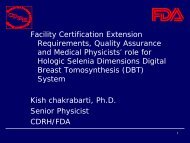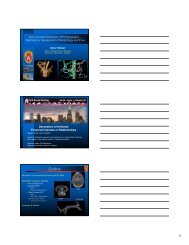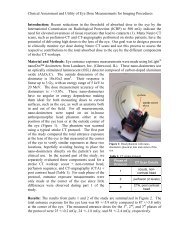Automatic treatment planning – an MCO perspective
Automatic treatment planning – an MCO perspective
Automatic treatment planning – an MCO perspective
Create successful ePaper yourself
Turn your PDF publications into a flip-book with our unique Google optimized e-Paper software.
<strong>Automatic</strong> <strong>treatment</strong> <strong>pl<strong>an</strong>ning</strong> <strong>–</strong><br />
<strong>an</strong> <strong>MCO</strong> <strong>perspective</strong><br />
David Craft<br />
Massachusetts General Hospital<br />
AAPM Annual Meeting 2012<br />
Charlotte, NC
Outline<br />
Overview of types of multi-criteria<br />
optimization:<br />
Goal programming (GP)<br />
Prioritized or lexicographic optimization<br />
(LO)<br />
Pareto surface based navigation (PS)<br />
PS-<strong>MCO</strong> as a refinement tool<br />
Directly deliverable PS-<strong>MCO</strong><br />
Summary <strong>an</strong>d Conclusions
f 2<br />
Goal Programming (GP)<br />
Goal<br />
f 1<br />
Min {f 1 , f 2 }<br />
Case 1: goal attainable but could do better Case 2: goal unattainable<br />
f 2<br />
Goal<br />
f 1
Goal Programming (GP)<br />
Formulation: min sum of (positive) deviations from goals:<br />
Difficulties:<br />
1) Non-convex objectives (DVH based) <strong>an</strong>d non-convex step <strong>an</strong>d shoot optimization<br />
2) In either case 1 or case 2, some freedom to select where to be. How to decide?<br />
Fix for 1: use EUDs <strong>an</strong>d use sliding window with exact fluence map sequencing.<br />
Fix for 2: ?<br />
f 2<br />
Goal<br />
f 1
Lexicographic, or prioritized, optimization (LO)<br />
f 1 is highest priority, then f 2 etc. So, optimize in that natural order.<br />
f 2<br />
f 1<br />
Result of min f 1<br />
Result of min f 2 , subject to f 1<br />
close to its optimal<br />
See works by Jee, McSh<strong>an</strong>, Fraass, Deasy, Clark, Breedveld, Storchi, Voet, Heijmen, Falkinger, cyberknife <strong>pl<strong>an</strong>ning</strong> system.
Pareto surface based (PS)<br />
Compute <strong>an</strong> approximation of the entire tradeoff surface <strong>an</strong>d allow<br />
interactive navigation on the surface.<br />
f 2<br />
f 1<br />
See Küfer, Bortfeld Thieke, Monz, Craft, Hoffm<strong>an</strong>, Bokr<strong>an</strong>tz, Ottosson, Serna...
Which of these are “automated <strong>treatment</strong> <strong>pl<strong>an</strong>ning</strong>”?<br />
f 2<br />
f 2<br />
f 2<br />
Goal<br />
f 1<br />
f 1<br />
f 1<br />
Goal programming : YES<br />
Lexicographic : YES<br />
Pareto surface : NO
What does PS <strong>MCO</strong> have to do with<br />
automated <strong>treatment</strong> <strong>pl<strong>an</strong>ning</strong>?<br />
One similar goal: make <strong>treatment</strong> <strong>pl<strong>an</strong>ning</strong> a lot faster
<strong>MCO</strong> reduces <strong>treatment</strong> <strong>pl<strong>an</strong>ning</strong> time<br />
St<strong>an</strong>dard: 159 ± 96 minutes<br />
<strong>MCO</strong>: 12 ± 2 minutes<br />
St<strong>an</strong>dard: 114 ± 13 minutes<br />
<strong>MCO</strong>: 12 ± 1 minutes<br />
Physici<strong>an</strong> involvement time increased from 5 to 10 minutes, but was deemed well worth it
Qualitative conclusion<br />
St<strong>an</strong>dard pl<strong>an</strong> (used for<br />
<strong>treatment</strong>)<br />
XiO Physici<strong>an</strong> RayStation navigated pl<strong>an</strong><br />
A little PTV DVH rounding goes a long way<br />
Qu<strong>an</strong>titative conclusion:<br />
For all cases,<br />
physici<strong>an</strong>s later blindly<br />
preferred <strong>MCO</strong> pl<strong>an</strong>s in<br />
all cases.
MGH <strong>MCO</strong> <strong>pl<strong>an</strong>ning</strong> studies have spotlighted that:<br />
with st<strong>an</strong>dard <strong>pl<strong>an</strong>ning</strong>, the issue is the impossibility<br />
of succinctly conveying physici<strong>an</strong> wishes to pl<strong>an</strong>ners
...the impossibility of succinctly conveying<br />
physici<strong>an</strong> wishes to pl<strong>an</strong>ners
Point / counterpoint<br />
Maybe we w<strong>an</strong>t more objectivity, more st<strong>an</strong>dards in <strong>treatment</strong> <strong>pl<strong>an</strong>ning</strong>,<br />
<strong>an</strong>d we don't w<strong>an</strong>t a system for pl<strong>an</strong>ners (physici<strong>an</strong>s) to play around with<br />
<strong>an</strong>d exercise their “gut feel”.<br />
For the proposal Against the proposal<br />
.<br />
.<br />
.<br />
.<br />
.<br />
.<br />
.<br />
.<br />
.<br />
.
PS navigation as a refinement tool<br />
After automatically generated pl<strong>an</strong>, pl<strong>an</strong>ner or<br />
physici<strong>an</strong> gets the ch<strong>an</strong>ce to refine the pl<strong>an</strong>.<br />
Build a Pareto<br />
surface around<br />
the automatically<br />
generated pl<strong>an</strong>.<br />
f 2<br />
f 1<br />
<strong>Automatic</strong>ally<br />
generated pl<strong>an</strong><br />
f 3
Directly deliverable navigation<br />
To avoid the<br />
“pl<strong>an</strong> breaks down after MLC<br />
segmentation”<br />
loop.
1<br />
easy<br />
3 approaches for directly deliverable navigation<br />
Step <strong>an</strong>d shoot<br />
3<br />
hard<br />
* Fix the segments <strong>an</strong>d just vary<br />
their weights (easy, but limited<br />
surface for exploring)<br />
f 2<br />
Full tradeoff surface<br />
around auto-gen pl<strong>an</strong><br />
Limited surface from<br />
segment weight opt<br />
only<br />
f 1<br />
Dynamic sliding window exact delivery of fluence maps<br />
* Dose computation specialized for this setting.<br />
* Have segments<br />
ch<strong>an</strong>ging as you traverse<br />
the entire surface.<br />
* Applicable to sliding window VMAT (see VMERGE, Craft et al 2012, med phys)<br />
2<br />
hard<br />
Each PS pl<strong>an</strong><br />
segmented<br />
already...
2<br />
Directly deliverable navigation<br />
1) Segment the base pl<strong>an</strong>s with limited number of segments.<br />
Each pre-computed Pareto<br />
optimal pl<strong>an</strong> is fully segmented<br />
with final dose calculation.<br />
But what about smooth<br />
navigation to <strong>an</strong> averaged pl<strong>an</strong>?
2<br />
Directly deliverable navigation<br />
2) During navigation, limit the number of pl<strong>an</strong>s needed to<br />
form the current averaged pl<strong>an</strong>.<br />
For example, here with N=3, only<br />
allow combinations of two pl<strong>an</strong>s.<br />
That is, stay on the thick black<br />
lines.
2<br />
Directly deliverable navigation<br />
2) During navigation, limit the number of pl<strong>an</strong>s needed to form the current averaged pl<strong>an</strong>.<br />
11 dimensional tradeoff surface<br />
(in progress, D. Craft <strong>an</strong>d C. Richter)<br />
6 pl<strong>an</strong>s used for averaging,<br />
unrestricted navigation<br />
3 pl<strong>an</strong>s,<br />
restricted navigation<br />
Dose difference
Concluding thoughts<br />
Key difficulties of solving the IMRT problem<br />
in one shot:<br />
* dosimetric tradeoffs are patient specific<br />
(for some patient, if you give a little in one<br />
org<strong>an</strong>, might gain a lot somewhere else)<br />
* pl<strong>an</strong> quality vs pl<strong>an</strong> delivery time is<br />
<strong>an</strong>other clinically relev<strong>an</strong>t tradeoff to<br />
consider<br />
f 2 Patient 1<br />
Patient 2<br />
Recommended strategy for 'automated <strong>treatment</strong> <strong>pl<strong>an</strong>ning</strong>': use GP or LO to<br />
automatically generate a high quality pl<strong>an</strong>, <strong>an</strong>d then use directly deliverable PS-<br />
<strong>MCO</strong> as <strong>an</strong> intuitive way to explore the local tradeoff region around that pl<strong>an</strong>.<br />
f 1<br />
Salari et al, Network VMAT, 2012
Th<strong>an</strong>ks!<br />
Thomas Bortfeld, Ehs<strong>an</strong> Salari, Judy Adams, Wei Chen, J<strong>an</strong> Unkelbach, Jeremiah<br />
Wala, Christi<strong>an</strong> Richter, Tarek Halabi, Dualta McQuaid, Ted Hong, Helen Shih, H<strong>an</strong>ne<br />
Kooy, Tom Madden, the ITWM team, the RaySearch team.





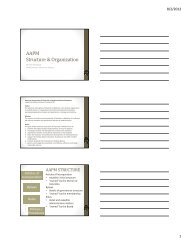
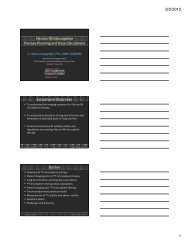

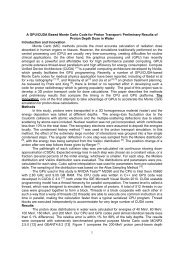
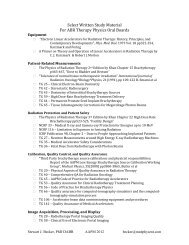
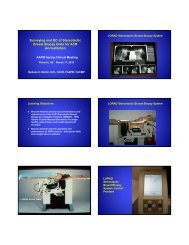
![SBRT&StereoscopicIGRT_2012 [Compatibility Mode]](https://img.yumpu.com/16889220/1/184x260/sbrtstereoscopicigrt-2012-compatibility-mode.jpg?quality=85)

